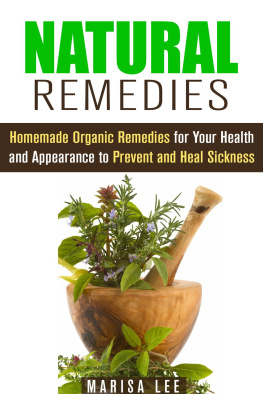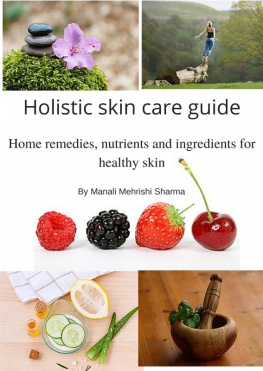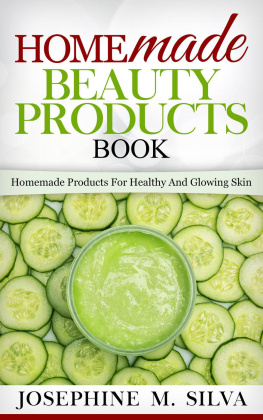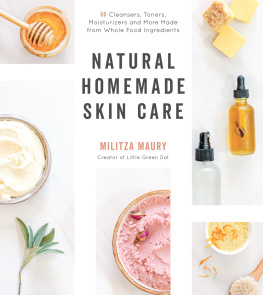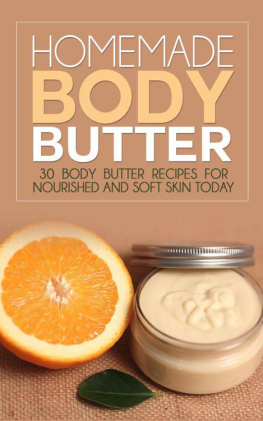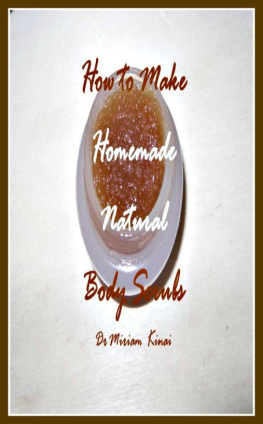Homemade Natural Skin Remedies
Chemical-Free Recipes for Luxurious & Healthy Skin
Copyright Notice
Reproduction, duplication, transmission of this document in part or in whole is permitted only with written permission from the publisher. All rights reserved.
Respective brands and trademarks mentioned in this book belong to their respective owners.
Disclaimer
This document is geared towards providing summarization of information related to the topic. While all attempts have been made to verify the accuracy of the information, the author does not assume any responsibility for errors, omissions, or interpretations of the content. The information is offered for informational or entertainment purposes only. If professional advice is necessary, a qualified legal, medical, financial or another respective professional should be consulted. The reader is responsible for his or her own actions. The publisher does not accept any responsibility or liability arising from damages or losses, real or perceived, direct or indirect, resulting from the use of this information.
Table of Contents
Bonus: Your FREE Gift

As a token of our appreciation, please take advantage of the FREE Gift - a lifetime VIP Membership at our book club.

or open it in your browser: http://bit.ly/vipbooks
As a VIP member, you will get an instant FREE access to exclusive new releases and bestselling books.
Learn more

Introduction
T he truth is, most people do not know much about their skin. Our skin is something we confront on a daily basis, whether we are looking in mirrors or see our reflection in the car.
Do you want to look in the mirror and see a clear, clean face or one with acne? Do you want to fix your blemishes? Do you want to decode the mystery of your skin?
Instead of trying to dig deep into the facts we spend money on overpriced skin products that charge us more for convenience than anything else. This book will show you how to beat that.
By not only providing recipes and additional information throughout but also the word for word explanations that will enable you to take such knowledge and use it on your own accord.
Regular skin care products at the store just tell you what their specific product does, but they fail to elaborate on ingredients. They ignore the how and what questions.
This book will answer, in great detail, the how and the what questions, by providing you with great recipes, tips & tricks, general advice, straight up facts, and much more.
Chapter One: The Importance of Healthy Skin
O n the Surface
In this chapter, you will learn:
- What skin is
- What has the greatest effect on your skin
The Basics
O ur entire bodies are covered in it, we see it every day, and we may or may not clean it every day. Yes, Im talking about skin. It is a part of ourselves that we see every day, but many would not be able to say they knew much about it. Indeed, there are many things about our skin that we do not take into account on a daily basis, so lets take it from the top.
What Is Skin
Did you know that skin is the bodys largest organ? Did you know that skin is even an organ? In fact, it is without a doubt the most important organ in, or should I say on the human body. It is held responsible for a multitude of various functions. First and foremost, it protects our inner organs. Suffice to say, without any skin to contain and hold together our inner parts, the human body would simply fall apart. Secondly, skin is in charge of regulating the temperature of the body. This means the skin is what alerts your brain to dangerous conditions such as hypothermia. Third, it acts as a wall against contagious bacteria and disease that can prove to be potential threats to our inner as well as our parts. Fourthly, like the act of photosynthesis that takes place between a plant and the sun, our skin too is able to transform sunlight into vitamin D, which makes the body stronger by boosting its immune system and supporting metabolic functions, just to name a couple of the many. Lastly, our skin is also rather sensitive. It is full of meticulous nerve endings that transmit messages of cold and heat, along with touch, sexual arousal, and pain to the brain.
The skin consists of two separate layers: There is the internal dermis and external epidermis. The epidermis is a slightly transparent, sheer layer of the skin. It can be broken into three parts: the basal, the squamous cells, and the dead skin cells that collect in hair as dandruff and in the nails as well. These dead skin cells are often shed typically due to daily washings and hygienic maintenance, in general, which is why both are so important. After the dead cells are done away with, new cells come up to the external surface. This process takes around a month to come full circle. Then the new cells gradually die off and become dead skin cells. Because of this the skin is considered an organ that replenishes itself naturally. This timing of this process, however, depends on each specific area of the skin. For example, skin which covers the soles of the feet or palms of the hands, tend to be thicker and so the replenishing process takes more time. The epidermis also contains melanin, which is responsible for skin color and protection from sunlight.
Further below the epidermis is the dense dermis, which holds proteins, called elastin and collagen, both of which attribute to strengthening the skin while also adding to its soft and elastic qualities. The dermis is also where some of the less appealing aspects of the skin live. There are glands, which secrete oil, and glands that produce sweat. The oiliest of the glands are abundant in the chest, scalp, face, and genital areas. Contrary to popular belief, this oil actually protects the exterior skin by secreting oil called sebum that comes up through the follicles of the hair, lubricating the outer parts.
Skin can be separated into multiple types according to the amount of oiliness. Preferable skin, one that is balanced between dry and oily, would go into the balanced group. Adolescents, or simply teenagers, have an increased likelihood of suffering from oily skin, hence why many teens have acne problems, the effect of an overflow of sebaceous glands.
What Effects Your Skin
Y ou would be surprised how just about every facet of your life affects the condition of your skin. It is everything, honestly. Your skin is an unblemished reflection of your health and lifestyle choices. Believe it or not but most skin related problems that people have, stem directly from their diet. You cannot go about eating greasy foods and only expect to gain weight. The better choices you make regarding your lifestyle and your diet the healthier your skin will be and stay in the long run. Here are some lifestyles that can affect the condition of your skin.
Stress
This is the one that many people have problems avoiding. It is perplexing to know that how you think and feel can have a direct impact on your health and, therefore, your skin. Most of our habits that relate to stress have negative effects on the skin. This can be anything from nervously biting your lip till you split and wound your skin. Perhaps you rub and scratch your skin obsessively when you become nervous; this can lead to a skin disease called dermatitis. Even if you make it a habit of taking steaming hot showers to relieve stress you are indirectly putting more stress on your skin. Hot water makes skin irritated and dehydrated.
Next page


